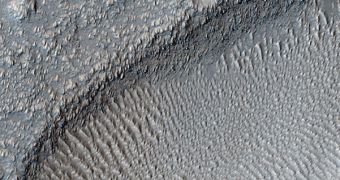As the Mars Express and the Mars Reconnaissance Orbiter (MRO) spacecraft swirl around the Red Planet, they continuously transmit back data and photographs of our neighbor's surface. They have been doing this for several years, and, during that time, experts have come across a number of very interesting features on Mars. Some of these features are channels, which appear to have been caused by the flow of water. However, there are those who oppose the idea, Space reports.
After carefully examining a large number of images, geologists have concluded that some of the channels are very similar to the ones left behind by slow-moving water streams back on our own planet. The meandering could have only be caused by liquid water, flowing over what once must have been a place suited to support the emergence and development of life. “We've gotten over the hump and can now agree that water flowed on the Martian surface in the past,” University of Virginia expert Alan Howard adds.
There are, of course, critics to these ideas. They mainly argue that lava, wind and glaciers, among other slow-acting geological factors, may have been responsible for the development of the channels. However, the majority of the scientific community believes that this is not the case for a very simple reason – the fact that these elements cannot account for all the subtle variations in the channels, as well as for their complexity. Howard and colleagues are set to embark on a new expedition to analyze the channels, which will take them from the polar regions to the hottest deserts.
They argue that they need to find what kept the Martian soil in place as the water eroded the channels. On our planet, this is known to be caused by floodplains resistant to erosion, and also by trees and grass keeping the soil firmly in place. Vegetation such as this most likely didn't exist on Mars, so experts are very curious as to what held the terrain in place. Some of the more outstanding theories say that clay, ice, or some yet-unidentified array of chemical processes might have been responsible.
“The width and branching character of the channels is consistent with episodes of rain or snow, but it seems difficult to have precipitation that recently,” Howard says. He is speaking about a two-billion-year-old set of channels, which appear to have experienced alternative precipitations. However, two billion years is a very short time, geologically speaking. “We suspect clay sediment is providing the necessary cohesion,” he concludes.

 14 DAY TRIAL //
14 DAY TRIAL //